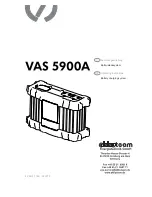
•
3
•
2. IMPORTANT SAFETY INSTRUCTIONS
SAVE THESE INSTRUCTIONS.
2.1 SAVE THESE INSTRUCTIONS –
This manual contains important safety
and operating instructions.
2.2
Children should be supervised to ensure
that they do not play with the appliance.
This appliance is not intended for use by
persons (including children) with reduced
physical, sensory or mental capabilities or
lack of experience and knowledge unless
they have been given supervision or
instruction concerning use of the appliance
in a safe way and understand the hazards
involved. Children shall not play with the
appliance. Cleaning and user maintenance
shall not be made by children without
supervision.
2.3
Do not expose the charger to rain or snow.
2.4
Use of an attachment not recommended
or sold by the battery charger
manufacturer may result in a risk of fire,
electric shock or injury to persons.
2.5
To reduce the risk of damage to electric
plug and cord, pull by the plug rather than
the cord when disconnecting charger.
2.6
An extension cord should not be used
unless absolutely necessary. Use of
improper extension cord could result
in a risk of fire and electric shock. If an
extension cord must be used, make sure:
• The pins on plug of extension cord are
the same number, size and shape as
those of plug on charger.
• The extension cord is properly wired and
in good electrical condition.
• The wire size is large enough for AC
ampere rating of charger as specified in
section 9.
2.7
Do not operate the charger with a damaged
cord or plug. If the supply cord is damaged,
it must be replaced by the manufacturer, its
service agent or similarly qualified persons
in order to avoid a hazard.
2.8
Do not operate charger if it has received
a sharp blow, been dropped, or otherwise
damaged in any way; take it to a qualified
serviceman.
2.9
Do not disassemble charger; take it to
a qualified serviceman when service or
repair is required. Incorrect reassembly
may result in a risk of electric shock or fire.
2.10
To reduce risk of electric shock, unplug
charger from outlet before attempting
any maintenance or cleaning. Turning off
controls will not reduce this risk.
2.11 WARNING:
RISK OF EXPLOSIVE GASES.
a.
WORKING IN VICINITY OF A LEAD-
ACID BATTERY IS DANGEROUS.
BATTERIES GENERATE EXPLOSIVE
GASES DURING NORMAL BATTERY
OPERATION. FOR THIS REASON, IT
IS OF UTMOST IMPORTANCE THAT
YOU FOLLOW THE INSTRUCTIONS
EACH TIME YOU USE THE
CHARGER.
b.
To reduce risk of battery explosion,
follow these instructions and those
published by battery manufacturer
and manufacturer of any equipment
you intend to use in vicinity of battery.
Review cautionary markings on these
products and on engine.
2.12
Do not use with non-rechargeable batteries.
3. PERSONAL SAFETY PRECAUTIONS
3.1
Consider having someone close enough
by to come to your aid when you work
near a lead-acid battery.
3.2
Have plenty of fresh water and soap
nearby in case battery acid contacts skin,
clothing, or eyes.
3.3
Wear complete eye protection and
clothing protection. Avoid touching eyes
while working near battery.
3.4
If battery acid contacts skin or clothing,
wash immediately with soap and water.
If acid enters eye, immediately flood
eye with running cold water for at least
10 minutes and get medical attention
immediately.
3.5
NEVER smoke or allow a spark or flame
in vicinity of battery or engine.
3.6
Be extra cautious to reduce risk of
dropping a metal tool onto battery. It might
spark or short-circuit battery or other
electrical part that may cause explosion.
3.7
Remove personal metal items such as
rings, bracelets, necklaces, and watches
when working with a lead-acid battery. A
lead-acid battery can produce a short-
circuit current high enough to weld a ring
or the like to metal, causing a severe burn.
3.8
Use this charger for charging only 6V and
12V LEAD-ACID (STD, AGM or GEL) and
12V Lithium Ion (LiFePO
4
) rechargeable
batteries with recommended rated
Содержание DSR PROSERIES DSR5254
Страница 14: ... 14 ...




































